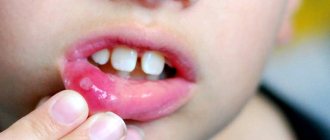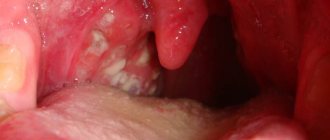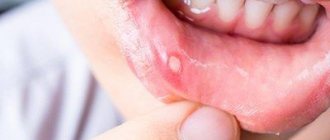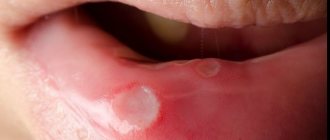Signs of stomatitis in children
To identify the cause of the child’s nervousness and capricious state, he must be carefully examined. The disease may not appear externally, so you need to examine the oral cavity, feel the tummy, and put your hand to the head. The first reason for refusing to eat may be the presence of small wounds in the oral cavity. A disease such as stomatitis exhibits similar symptoms.
The first signs of the disease can be recognized even without medical education: the tongue becomes covered with a white coating, as does the entire oral cavity. The presence of sores on the inside of the cheeks, lips and palate can cause a rise in temperature. If you notice such symptoms, you should immediately consult a doctor for help. A dentist can diagnose the disease and prescribe treatment. It is recommended to first consult with a pediatrician, who can indicate effective methods and methods of treatment.
In children, stomatitis can occur suddenly due to several reasons that contribute to the development of infection. When an inflammatory process appears in the oral cavity, the child will experience severe pain when trying to eat. The causative agents of this disease are different types of bacteria:
- Candida mushrooms;
- Allergic stomatitis;
- Herpes virus.
Dentists' recommendations
Prevention of aphthous stomatitis is the surest way to prevent the disease in children. Parents of children with a hereditary predisposition, chronic diseases or weakened immunity should pay the greatest attention to preventive measures.
To reduce the risk of developing aphthous stomatitis, dentists recommend:
- monitoring the child's nutrition;
- exclusion of allergenic products (if indicated);
- periodic intake of vitamin complexes;
- maintaining oral hygiene at home;
- professional teeth cleaning every 6 months;
- timely treatment of dental diseases;
- treatment of any provoking diseases;
- contact your dentist at the first symptoms of aphthae.
Aphthous stomatitis is a complex dental disease caused by infection. Treatment of infectious pathology at home often only helps to eliminate symptoms and transition of the disease to a chronic form. Contacting a qualified dentist will allow you to individually select treatment tactics for complete recovery or achieve long-term remission with subsequent “attenuation” of the infection.
Inflammation of the oral cavity in a child: causes, treatment
Pathogenic bacteria do not select their hosts based on age; for them, the main factor is a beneficial environment. Children, as a rule, are more susceptible to this type of infection than adults, because... the body is weaker and does not have a strong enough immune system.
If a child has been infected with pathogenic bacteria, this does not mean that the parents are providing poor care; today, the risk zone for children is modern sweets, many of them may already contain strains of viruses, depending on where and by whom they are produced, and as a result, they can cause caries and other dangerous diseases. For example, as a result of an examination, a doctor can diagnose stomatitis.
We are talking not only about school-age children, but also about infants who feed on their mother’s breasts, since bacteria can also be transmitted through milk. Children aged from birth to three years old can suffer from candidal stomatitis. After three years, they may develop herpetic stomatitis. This occurs when a child is denied a pacifier and begins to suck dirty fingers, which leads to the spread of bacteria in the oral cavity and the formation of small ulcers in size and shape. In this case, stomatitis in children in the mouth can be dangerous and treatment must be carried out very quickly, since the child will not be able to eat food at all, which will negatively affect his general condition and activity, not to mention the terrible pain that the child will experience.
School-aged children may also be susceptible to oral inflammation. In them, the disease takes the form of allergenic or aphthozonal stomatitis. It should be noted that an unhealthy lifestyle, unsanitary conditions, dirty cutlery or lack thereof can lead to adults also getting stomatitis. When it comes to children, it is necessary to conduct preventive and educational conversations about the need to always take care of hygiene, because clean hands are a guarantee of protection against the occurrence of stomatitis and intestinal diseases.
Stomatitis is more common in children. This is explained by the fact that in babies the mucous membrane in the oral cavity is much more tender and thinner. This leads to its rapid injury and defeat. The child’s immune system cannot cope with a large number of bacteria, so wounds appear in the mouth, which are quite difficult to cure. At the initial stage, stomatitis in her child can be detected by the mother, who is always next to him. However, you should not experiment with treatment; it is important to identify the cause of the disease and undergo treatment. You can only take precautions by isolating the child in a separate room if there are other children in the family. The reason for isolation is simple: the disease is transmitted through airborne droplets.
The causative agent of the disease
Aphthous stomatitis is an infectious disease that develops after penetration of a pathogen into the body. The mucous membrane protects the tissues of the oral cavity from pathogenic microorganisms, but if damaged, the infection can penetrate inside. The causative agent of aphthous stomatitis does not immediately become active. If the patient has a strong immune system, then the incubation period begins. But when the immune system is weakened under the influence of any factors, the disease begins to progress.
There are several ways of contracting aphthous stomatitis.
- Contact and household. The infection enters the oral cavity from dirty hands, objects, products, etc.
- Interior. Every person’s body contains not only “good” bacteria, but also “bad” bacteria. When the immune system is weakened, pathogenic microorganisms begin to manifest themselves. These bacteria also include the causative agent of stomatitis.
- Pathological. The cause of the disease may be another disease of a bacterial or viral nature. Stomatitis is mainly observed against the background of measles, smallpox and herpes.
Most people suffer from stomatitis in childhood, which has a simple explanation - the immunity of children is much weaker than that of an adult. Even with the chronic form of the disease, as the child grows older, relapses occur less and less frequently.
Treatment of stomatitis in children of different ages
Stomatitis in children is a kind of profuse inflammation of the oral mucosa. It is necessary to treat the baby immediately and avoid extensive lesions. The child needs to be provided with special hygiene products with which he can regularly rinse his mouth.
If the baby is still very small, then he should treat his mouth with special napkins, on which a special solution - an antiseptic - is applied. Children over one year old can easily learn to rinse their mouth after eating, clearing it of dirt. This rinse will allow the sores to gradually heal as all bacteria and infections are destroyed. If stomatitis is not treated promptly, ulcers can spread throughout the entire oral cavity. In the future, this will lead to diphtheria, which is much more serious than stomatitis.
If an infant gets stomatitis, it means that nipples and bottles need to be carefully treated. Also, before each feeding, the mother’s nipples need to be treated, since various infections can be transmitted through them. Everything must be clean and sterile. If the child eats independently, then you need to ensure that the temperature of the food is equal to body temperature. In this case, he will use it without whims and stubbornness. Sour foods or particularly spicy foods should be excluded from the diet. If it is too painful for your child to eat, you can offer him food through a straw. This can be broth or liquid puree.
If a child with stomatitis refuses to eat, it is possible that he experiences severe pain while eating. In this case, you can use special gels that reduce the sensitivity threshold, and the child can eat little by little. If stomatitis is detected in a child, treatment must be started immediately. Nowadays, childhood stomatitis can be successfully treated, and the treatment itself can be completed in just a few days if you regularly rinse the mouth and monitor hygiene.
Sometimes there are situations when stomatitis is accompanied by the appearance of another disease - periodontitis. Here, home treatment is not enough, since periodontitis in children is treated in a specialized dental clinic or hospital. These diseases can be treated by the staff of the Dent Prestige dental clinic. Experienced specialists will always come to the aid of children and their parents.
Symptoms of stomatitis in children
The first symptom of stomatitis in a child that can be seen by relatives is dry, flaky lips. A small white coating may form on the tongue, which over time can spread throughout the mouth. Infants may well become infected with fungal stomatitis, which manifests itself in the form of small white spots. By their nature, the spots resemble milk that has curdled on the tongue. Sometimes such stomatitis can occur as a result of long-term treatment with antibiotics. That is why doctors do not recommend long-term use of such drugs.
An increase in temperature is one of the primary symptoms, which may also indicate that the child is sick. Lack of appetite, lethargy, whims - these are the first symptoms that need to be responded to in terms of diagnosing the oral cavity in a child.
Forms of the disease
Aphthous stomatitis can occur in two forms: chronic and acute. Each form of pathology has its own characteristics of symptoms, which help establish the clinical picture during diagnosis.
Acute form of aphthous stomatitis
The pathological condition is accompanied by puffiness and swelling of the mucous membrane, on which aphthae of gray or white color and round shape are formed. With timely initiation of treatment, acute stomatitis lasts up to 10 days. After therapy, the mucous membrane is completely restored.
Chronic form of aphthous stomatitis
It develops in the absence of treatment for acute stomatitis, hereditary predisposition or the presence of chronic diseases that affect the immune system. The peculiarity of the pathology is the occurrence of periodic relapses. The duration of the disease is up to 14–30 days.
Treatment of stomatitis using traditional medicine
Medical staff at children's clinics say that when stomatitis is detected, it is best to consult with your doctor. Only a specialist can identify what stage the disease is at and prescribe treatment. However, there are situations when the clinic is not open (for example, evening hours and night time), and the child is very sick and does not feel well. If stomatitis is detected at first, you can resort to traditional medicine. There is no need to think that the disease will go away on its own. If the infection is not eradicated, the child will get even more sick.
In case of stomatitis, the oral cavity should be wiped with a bandage containing a soda solution. Plaque in the mouth is removed with a bandage or a piece of gauze, thereby eliminating the infection. Making a soda solution is very easy: add one teaspoon of soda to one glass of water and mix thoroughly. Before use, the liquid should be stirred so that the soda does not remain at the bottom of the glass. Using soda, you can thoroughly disinfect the oral cavity and mucous membrane, while removing plaque.
You can also try wiping the inside with slimy brilliant green. Procedurally, you need to do the same as with a soda solution. Then soak in brilliant green and thoroughly wipe the child’s mouth.
For older children, you can prepare herbal infusions and give them a mouth rinse after eating. In this case, food particles will be removed, and the mucous membrane will not burst. You can rinse with a chamomile solution, which quickly removes the inflammatory process. It is not uncommon for people to use strong green tea, which is also used as a mouth rinse. This procedure should be carried out several times, and it is not at all necessary to do it after meals.
It is sometimes quite difficult to persuade young children to rinse their mouths, especially if they experience pain there. In this case, they may like rose syrup, which also has a positive effect on eliminating infections in the mouth. You can make this syrup yourself using rose petals, sugar and water. You can easily prepare a decoction of oak bark at home. Herbs you can choose from are burdock, sage, and yarrow. You can prepare a mixture of these herbs and rinse your mouth with the tincture several times a day.
You can also use aloe, which you can simply chew. If a child cannot swallow such a plant, then holding it in his mouth will be enough. Aloe will taste good together with a little honey. However, we must remember that using large amounts of honey for stomatitis can only worsen the disease. When a child is ill, you should use only high-quality products without acid and harsh sensations, which will not cause allergies and irritation of the mucous membrane. It is advisable to limit yourself to a set of dishes that were pleasant to the child and did not cause him discomfort.










